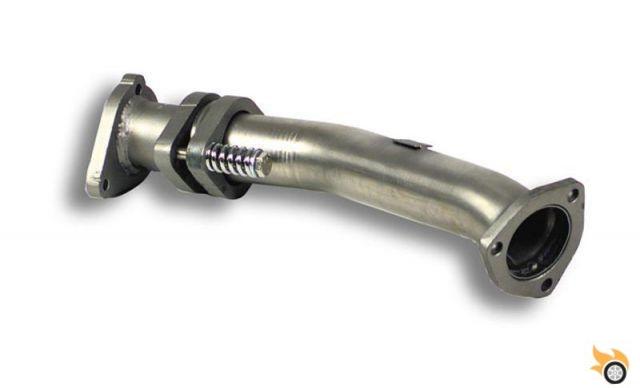
Introduction
Welcome to Pistonudos.com, where we are passionate about the world of mechanics and we are here to answer all your questions. In this article, we will cover the topic of the catalyst suppressor, its function, legality and maintenance. If you've ever wondered what a catalytic converter is, is it legal to use, or how to clean it instead of replacing it, you've come to the right place!
What is a catalytic converter suppressor?
Let's start by defining what a catalyst suppressor is. The catalytic converter is an essential component in a vehicle's exhaust system, designed to reduce polluting emissions. However, some drivers choose to remove the catalytic converter and replace it with a catalytic converter, which is a device that allows more exhaust gas flow by removing the restrictions on the catalyst.
Function and legality of the catalyst suppressor
The main function of a catalytic converter suppressor is to increase engine performance by improving exhaust gas flow. This can result in increased horsepower and exhaust noise. However, it is important to note that removing the catalytic converter may have legal consequences, as in many countries it is illegal to modify a vehicle's exhaust system in a way that increases polluting emissions.
The legality of using a catalyst suppressor varies according to the legislation of each country. Before considering its installation, it is essential to research and understand the local laws and the legal consequences that could result from its use. In some locations, the use of a catalyst suppressor can result in significant fines and invalidation of vehicle insurance.
Benefits and Disadvantages of Removing the Catalyst
Removing the catalyst can have both benefits and drawbacks. Next, we will analyze both aspects so that you can make an informed decision:
Services
- Increased Engine Power: By removing catalyst restrictions, exhaust gas flow is improved, which can result in increased engine power.
- Improved Exhaust Sound: Some drivers want a sportier sound from their vehicle's exhaust, and removing the catalytic converter can do just that.
Disadvantages
- Environmental impact: The catalytic converter is a component designed to reduce polluting emissions, so removing it can increase the amount of harmful gases released into the environment.
- Legal Consequences: As we mentioned above, removing the catalytic converter can be illegal in many countries and can result in fines and invalidation of vehicle insurance.
- Loss of fuel efficiency: In some cases, removing the catalytic converter can negatively affect the vehicle's fuel efficiency.
Is it possible to clean the catalyst suppressor instead of replacing it?
A common question is whether it is possible to clean the catalytic converter instead of replacing it. The answer depends on the state of the suppressor and the type of obstruction it presents. In some cases, it is possible to clean the suppressor using chemicals specifically designed to remove accumulated deposits. However, in most cases, the clogging is so severe that the only effective solution is to replace the catalyst suppressor.
Catalyst Suppressor Change Tips
If you have decided to change your catalytic converter, here are some helpful tips:
- Consult a Professional Mechanic: Before making any changes to your vehicle's exhaust system, it is advisable to seek the advice of an experienced mechanic. They will be able to assess the feasibility of the change and perform the installation correctly.
- Research local regulations: Make sure you are aware of local laws and regulations regarding exhaust system modification. This will help you avoid legal problems and fines.
- Choose a quality suppressor: If you decide to install a catalytic converter suppressor, be sure to choose a quality one that meets the proper standards. This will ensure optimal performance and increased durability.
- Maintain Proper Maintenance: Once your catalytic converter suppressor is installed, it is important to perform regular maintenance to ensure it is working properly. This includes periodically inspecting the suppressor and cleaning it if necessary.
Frequently Asked Questions (FAQs)
1. Is it legal to use a catalytic converter suppressor in my vehicle?
The legality of using a catalyst suppressor varies according to the legislation of each country. Before considering its installation, it is essential to research and understand the local laws and the legal consequences that could result from its use. In some locations, the use of a catalyst suppressor can result in significant fines and invalidation of vehicle insurance.
2. What is the primary function of a catalyst suppressor?
The main function of a catalytic converter suppressor is to increase engine performance by improving exhaust gas flow. This can result in increased horsepower and exhaust noise. However, it is important to note that removing the catalytic converter may have legal consequences, as in many countries it is illegal to modify a vehicle's exhaust system in a way that increases polluting emissions.
Conclusion
In short, the catalytic converter is a device that allows a greater flow of exhaust gases by removing the restrictions of the catalytic converter. If you are considering using a catalyst suppressor, it is important to consider both the benefits and drawbacks, as well as the legal implications. Always remember to consult with a professional mechanic and comply with local regulations. Proper maintenance is also essential to ensure optimal performance. We hope this article has been useful in solving your doubts about the catalyst suppressor. Leave us your comments and share your experience!
Until next time at Pistonudos.com!


























